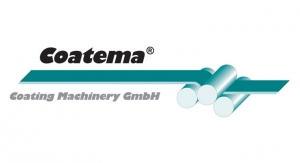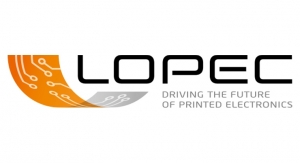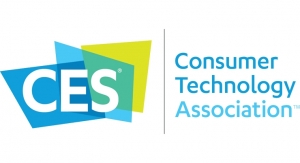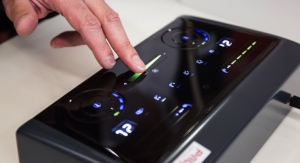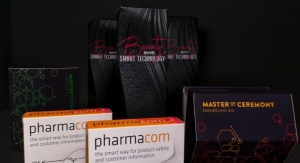David Savastano, Editor03.18.19
LOPEC 2019 opened March 19 with its Business Conference sessions, featuring four Business Conference sessions that brought success stories in flexible and printed electronics, as well as ideas for new possibilities.
LOPEC chair Wolfgang Mildner of mswTech welcomed attendees with a positive view of where the industry is heading.
“Business is really taking off,” Mildner said. We are looking forward to a record breaking exhibition. Printed electronics is a dynamic field with many applications. We can see products appearing on the market and technologies and processes that are adapted to these fields. We can see today that has happened and business is taking off. Printed electronics is thin and flexible, and we have to be flexible as well.”
Dr. Tarik Vardag, managing director of ATH, KROENERT, Coetema and ZAE, followed with “Development of New Processes and Optimization of Existing Processes – A Comprehensive Approach to Innovation for the Converting & Coating Industry.” ATH (Altonaer Technologie Holding) is the parent company of KROENERT and Drytec, and acquired Coatmea in 2018.
“Coatema is proactively developing opportunities, working together in parallel with 15 research projects,” said Dr. Vardag. He discussed Red Ocean environment, which are commodity markets that rely on either low cost or differentiation.
“The question is how a machine supplier can support customers in a Red Ocean environment,” he continued. “We have to help the customer to optimize processes and product while maintaining a high degree of quality and reducing cost.”
By contrast, Coatema customers are in the Blue Ocean environment, where competition is irrelevant, and low cost and differentiation is possible.
“A machine supplier can offer brains and machinery to experiment, such as providing testing facilities, be fast and support the roll-out of a technology,” Dr. Vardag pointed out. “An example is Coatema’s work with Temicon on TemiCoat Nanoimprint, which is adding function to existing products and creating new products. Together we provided a total solution, from testing to production. There are many new technologies waiting for a breakthrough. We can also support a customer who is shifting from Red to Blue Ocean.”
Thomas Kolbusch, VP of Coatema Coating Machinery GmbH, moderated the first session, End-User Applications and Requirements, opened the session with “HiLight - Printed OLEDs and Smart LEDs: Smart Packaging Solutions for Global Brand Owners - Success Stories and Key Learnings.”
KARL KNAUER KG is a packaging and converting leader that has developed unique packaging and advertising. €110 million in sales, working with many leading brands, including Coca-Cola, Pepsi-Cola/Marvel Studios, and Porsche, to name a few. The company has featured packaging using a variety of printed electronic features on them, including OLED and electroluminescent (EL) lighting.
“We have to win the first moment of truth, which is why we are interested in printed electronics. When you buy something, it is linked to emotions, which we are asked to provide to our customers,” Knapps said. “Smart packaging is more than lights. It is how smart it can be.”
Knapps noted that KARL KNAUER introduced a lighted box 14 years ago using OLED lighting, and has since moved on to major successes such as the Bombay Gin box and the Black Panther box for Pepsico.
“The Bombay Gin box is still something special, and it was a success for Bacardi,” Knapps observed. “There is a high potential for this technology. It needs to be recycled. We are the only packaging provider worldwide of three innovative lighting technologies – EL, OLED and HiLight smart LEDs.”
Black Panther-based cans were sent in a lighted box to social influencers by Pepsico, and the results were astonishing. “It was a huge success story with more than 550 million impressions,” Knapps said. “It was an unbelievable number. It shows how printed electronics can influence markets.”
Sri Vishnu Subramanian of OPVIUS was up next with his talk, “Pioneering Customization in Photovoltaic Production.” Subramanian focused on the need for solar to be adaptable to cities.
“Urbanization is a global megatrend, and land is very scarce and cannot be awarded to alternate technologies,” Subramanian noted. “We need lightweight and adaptable technology, and OPV is very robust. OPV technology can be integrated into our day to day life, like curtains or plaster. OPVIUS creates customized modules for each customer’s needs.”
Genes’Ink CEO Corinne Versini followed with “About the Reduction of Rare Metal Availability and its consequences on electronic. A new opportunity for flexible and printed electronics.”
Versini said that scarcity may be the biggest challenge that mankind has faced. “We know now that Earth will not be able to sustain mankind indefinitely. We have no choice,” Versini added.
“We are finding alternatives to raw material such as indium,” Versini continued. “Production of indium is relatively scarce. We are working on transparent conductive inks, but there are limited raw materials. GenesInk nano-solutions help decrease the consumption of raw materials and avoid pollution. Our TranDuctive ink is based on silver nanowires replacing ITO (indium tin oxide). Nano silver ink deposition is simple and uses robust processes for metal mesh, such as gravure, inkjet and screen printing.”
CYNORA CSO Thomas Baumann closed this session with “Will TADF Technology Change OLED Displays?” Baumann noted that red and green emitters are efficient, but current inefficient blue is a huge problem for OLED display makers.
‘CYNORA’s top priority is bringing the first efficient blue materials to the market,’ added Baumann. “As far as we know, CYNORA is the only company to have shown a real display blue. Color, efficiency and lifetime of blue emitters are all connected and cannot be judged separately. We are also looking into red and green emitters, and have already sent our first green materials for our customers to sample. The future of OLED is bendable and flexible, and we need to decrease the power consumption. TADF will play a major role in that.”
Stan Farnsworth, chief marketing officer for NovaCentrix, hosted the second morning session, Business and Product Developments.
Raynergy Tek Inc. CTO Dr. Yi-Ming Chang began this segment with “Challenges in the industrialization of non-fullerene organic photovoltaic technology.”
‘We are developing OPV for energy harvesting and organic photodetectors for testing,’ Dr. Chang said. “Non-fullerene with bandgap engineering could achieve PCE >14%. This will expedite commercialization of OPV technology.”
SENORICS CEO Dr. Ronny Timmreck was next with “Organic Based NIR-Photodetectors Enabling Miniaturized Spectroscopy Solutions.” SENORICS is a spin-off from IAPP of the TU Dresden group of Prof. Karl Leo, the same group that launched Novaled and Heliatek.
“SENORICS is commercializing a disruptive NIR-photodetector technology,” Dr. Timmreck said. “It is important to be able to solve problems. This can be used with food and automotive applications. We can use NIR-spectroscopy to detect and identify sugar, carbs, water and more. Our technology can be used for fruit quality and ripeness, quality detection of material and liquids in the automotive industry, among others.
“Spectroscopy today is only used in the lab,” Dr. Timmreck continued. “The device we have fabricated is a wavelength selective photodetector for NIR. We have industry projects on-going. Our first product is PLAN B, a measuring device for beer that measures sugar and alcohol levels during all production steps. This is ideal for small and craft brewers – it is portable, light and small with fast results.
Dr. Paul Harten, projekt manager, Helmholtz-Zentrum Berlin für Materialien und Energie GmbH, discussed “Joint Research with Industrial Partners in Perovskite and Silicon Technologies on Glass.”He focused on the HySPRINT (Hybrid Silicon Perovskite Integration & Novel Technologies) project.
“We are getting >20% reproducible efficiency and 25% verified perovskite/silicon tandem cell in-house,” Dr. Harten reported. “We are developing new compositions for perovskite, as well as microfluidic applications for silicon. We are cooperating with industrial partners on a variety of R&D projects.”
Dr. Anne De Villeroché, sales and marketing manager, SEQENS, followed with “Chemical Custom Manufacturing Boosting Electronic Organic Materials Development.” SEQENS produces specialty chemicals for electronics, including organic and printed electronics, including OLED, OPV, organic photodetectors (OPD) and organic thin film transistors (OTFT).
“There are stages of material development when going from lab to market,” De Villeroché observed. “It should take less than nine months depending on the chemical and the number of steps. It goes from defining customer needs to R&D study, scale-up and industrialization. High purity is one key of performance in organic electronics.”
Daniel Franke, associate, Performance Materials Venture Fund for M-Ventures, Merck's investment arm, closed the Business and Product Developments session with “Printed Electronics – View Point of a Venture Capital Fund.”
“It is a two-way street,” Franke said. “You have to find the right investment, while start-ups should look for the best possible investor. What can we bring to the company? Do we understand the technology, the markets, or both, and can we use our knowledge to help these companies?”
Franke then discussed a few of M Ventures investments in the printed electronics field.
“What makes a great printed electronics venture? One example is FeelIt, a flexible sensor enabling IoT in traditional industrial sectors. We can use other business sectors in Merck, like Life Sciences for bio-sensors,” Franke said. “CLEARink Displays make reflective displays with full color – Merck can support them with ink manufacturing and leverage Merck’s presence in Asia to help with customer engagement and manufacturing. Peratech could leverage Merck’s expertise in scale up, ink formulation and customer network. Electroninks’ printing platform is agnostic particle-free conductive inks. They have existing revenues from B2C business and a vertically-integrated investment syndicate.”
After lunch, Dr. Mark James, R&D director, head of organic electronics at Merck Chemicals Ltd., led the Supply-Chain Challenges and Changes session. Dr. Christoph Badock, managing director, Hoefer & Sohn GmbH, began the session with his insights into in-mold labeling (IML) and in-mold electronics in “The Right Touch Required – Automated Injection Molding of 3D Touch Panels.”
Hoefer & Sohn is a specialist in technical plastic components for markets as varied as automotive, medical, electronics, cosmetics, toys and white goods.
“Touch displays started in 1965, and every small kid knows how to deal with touch displays,” Dr. Badock said. “There are many more opportunities in your home and in automotive. This will be very exciting.
“When we started in 2013 with white goods, we got the task for a curved touch display using a metal mesh sensor supplied by our customer, using a Poly-TC sensor from PolyIC,” he noted. “The IML process allows a cost-efficient solution for 3D touch surfaces, We do high volume production of more than one million a year. We have considerable freedom of design with the flexible PolyTC sensor. There are promising prospects for stronger curvature.”
Peratech CEO Jon Stark continued with “A Co-Innovation Business Model for Tech Start-Ups.”
“Key discussion points include the ability to demonstrate proof points to accelerate market entry, who did we find sources of value with our partners as well as what value we could deliver, and how do we make it sustainable and protect and grow IP,” Stark said. “You have to demonstrate market opportunity, have the technology value and supply chain readiness.”
Dr. Brian Cobb, VP product and applications, PragmatIC, was next with “Iterative, Rapid Design and Manufacture of Flexible Integrated Circuits.”
“We are a thin film transistor company, using flexible substrates and form factors,” Dr. Cobb noted. “We have wafer-based production. We have a fully integrated line for FlexIC that produces a wafer every six to eight minutes. The capex is 100 to 1000 times lower than a silicon foundry. FlexIC can enable trillions of smart objects at a cost of a few cents per piece.”
Carolina Gioscio, marketing manager sustainable businesses, Evonik Creavis GmbH, closed the session with “A New Energy Storage Technology for the Internet of Things.”
Evonik has developed TAeTTOOz, printed batteries that feature organic materials that are non-toxic, rechargeable and a flexible power source and can be processed via printing technologies.
“Batteries still set boundaries for the smart sensors they power,” said Gioscio. “Devices are typically designed around the battery, and placing discrete components like batteries hinders productivity gains. Pick and place systems require investment in tooling and eventually become a bottle-neck for production. The solution we have is TAeTTOOz materials, which can be used to make a fully printable, ultra-thin and flexible battery. We use organic polymers formulated with carbon. It can be seamlessly integrated into the device, and can be screenprinted. No special disposal process is needed. It is safe for people and the environment.”
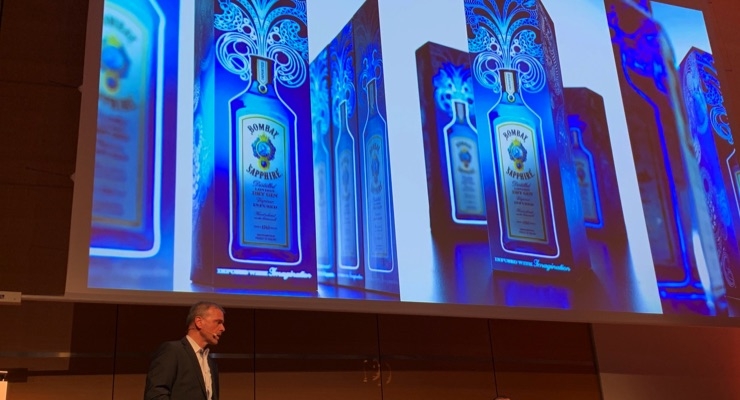
Juergen Knapps, key account manager, KARL KNAUER KG, discusses the Bombay Gin box featuring printed electronics.
LOPEC chair Wolfgang Mildner of mswTech welcomed attendees with a positive view of where the industry is heading.
“Business is really taking off,” Mildner said. We are looking forward to a record breaking exhibition. Printed electronics is a dynamic field with many applications. We can see products appearing on the market and technologies and processes that are adapted to these fields. We can see today that has happened and business is taking off. Printed electronics is thin and flexible, and we have to be flexible as well.”
Dr. Tarik Vardag, managing director of ATH, KROENERT, Coetema and ZAE, followed with “Development of New Processes and Optimization of Existing Processes – A Comprehensive Approach to Innovation for the Converting & Coating Industry.” ATH (Altonaer Technologie Holding) is the parent company of KROENERT and Drytec, and acquired Coatmea in 2018.
“Coatema is proactively developing opportunities, working together in parallel with 15 research projects,” said Dr. Vardag. He discussed Red Ocean environment, which are commodity markets that rely on either low cost or differentiation.
“The question is how a machine supplier can support customers in a Red Ocean environment,” he continued. “We have to help the customer to optimize processes and product while maintaining a high degree of quality and reducing cost.”
By contrast, Coatema customers are in the Blue Ocean environment, where competition is irrelevant, and low cost and differentiation is possible.
“A machine supplier can offer brains and machinery to experiment, such as providing testing facilities, be fast and support the roll-out of a technology,” Dr. Vardag pointed out. “An example is Coatema’s work with Temicon on TemiCoat Nanoimprint, which is adding function to existing products and creating new products. Together we provided a total solution, from testing to production. There are many new technologies waiting for a breakthrough. We can also support a customer who is shifting from Red to Blue Ocean.”
Thomas Kolbusch, VP of Coatema Coating Machinery GmbH, moderated the first session, End-User Applications and Requirements, opened the session with “HiLight - Printed OLEDs and Smart LEDs: Smart Packaging Solutions for Global Brand Owners - Success Stories and Key Learnings.”
KARL KNAUER KG is a packaging and converting leader that has developed unique packaging and advertising. €110 million in sales, working with many leading brands, including Coca-Cola, Pepsi-Cola/Marvel Studios, and Porsche, to name a few. The company has featured packaging using a variety of printed electronic features on them, including OLED and electroluminescent (EL) lighting.
“We have to win the first moment of truth, which is why we are interested in printed electronics. When you buy something, it is linked to emotions, which we are asked to provide to our customers,” Knapps said. “Smart packaging is more than lights. It is how smart it can be.”
Knapps noted that KARL KNAUER introduced a lighted box 14 years ago using OLED lighting, and has since moved on to major successes such as the Bombay Gin box and the Black Panther box for Pepsico.
“The Bombay Gin box is still something special, and it was a success for Bacardi,” Knapps observed. “There is a high potential for this technology. It needs to be recycled. We are the only packaging provider worldwide of three innovative lighting technologies – EL, OLED and HiLight smart LEDs.”
Black Panther-based cans were sent in a lighted box to social influencers by Pepsico, and the results were astonishing. “It was a huge success story with more than 550 million impressions,” Knapps said. “It was an unbelievable number. It shows how printed electronics can influence markets.”
Sri Vishnu Subramanian of OPVIUS was up next with his talk, “Pioneering Customization in Photovoltaic Production.” Subramanian focused on the need for solar to be adaptable to cities.
“Urbanization is a global megatrend, and land is very scarce and cannot be awarded to alternate technologies,” Subramanian noted. “We need lightweight and adaptable technology, and OPV is very robust. OPV technology can be integrated into our day to day life, like curtains or plaster. OPVIUS creates customized modules for each customer’s needs.”
Genes’Ink CEO Corinne Versini followed with “About the Reduction of Rare Metal Availability and its consequences on electronic. A new opportunity for flexible and printed electronics.”
Versini said that scarcity may be the biggest challenge that mankind has faced. “We know now that Earth will not be able to sustain mankind indefinitely. We have no choice,” Versini added.
“We are finding alternatives to raw material such as indium,” Versini continued. “Production of indium is relatively scarce. We are working on transparent conductive inks, but there are limited raw materials. GenesInk nano-solutions help decrease the consumption of raw materials and avoid pollution. Our TranDuctive ink is based on silver nanowires replacing ITO (indium tin oxide). Nano silver ink deposition is simple and uses robust processes for metal mesh, such as gravure, inkjet and screen printing.”
CYNORA CSO Thomas Baumann closed this session with “Will TADF Technology Change OLED Displays?” Baumann noted that red and green emitters are efficient, but current inefficient blue is a huge problem for OLED display makers.
‘CYNORA’s top priority is bringing the first efficient blue materials to the market,’ added Baumann. “As far as we know, CYNORA is the only company to have shown a real display blue. Color, efficiency and lifetime of blue emitters are all connected and cannot be judged separately. We are also looking into red and green emitters, and have already sent our first green materials for our customers to sample. The future of OLED is bendable and flexible, and we need to decrease the power consumption. TADF will play a major role in that.”
Stan Farnsworth, chief marketing officer for NovaCentrix, hosted the second morning session, Business and Product Developments.
Raynergy Tek Inc. CTO Dr. Yi-Ming Chang began this segment with “Challenges in the industrialization of non-fullerene organic photovoltaic technology.”
‘We are developing OPV for energy harvesting and organic photodetectors for testing,’ Dr. Chang said. “Non-fullerene with bandgap engineering could achieve PCE >14%. This will expedite commercialization of OPV technology.”
SENORICS CEO Dr. Ronny Timmreck was next with “Organic Based NIR-Photodetectors Enabling Miniaturized Spectroscopy Solutions.” SENORICS is a spin-off from IAPP of the TU Dresden group of Prof. Karl Leo, the same group that launched Novaled and Heliatek.
“SENORICS is commercializing a disruptive NIR-photodetector technology,” Dr. Timmreck said. “It is important to be able to solve problems. This can be used with food and automotive applications. We can use NIR-spectroscopy to detect and identify sugar, carbs, water and more. Our technology can be used for fruit quality and ripeness, quality detection of material and liquids in the automotive industry, among others.
“Spectroscopy today is only used in the lab,” Dr. Timmreck continued. “The device we have fabricated is a wavelength selective photodetector for NIR. We have industry projects on-going. Our first product is PLAN B, a measuring device for beer that measures sugar and alcohol levels during all production steps. This is ideal for small and craft brewers – it is portable, light and small with fast results.
Dr. Paul Harten, projekt manager, Helmholtz-Zentrum Berlin für Materialien und Energie GmbH, discussed “Joint Research with Industrial Partners in Perovskite and Silicon Technologies on Glass.”He focused on the HySPRINT (Hybrid Silicon Perovskite Integration & Novel Technologies) project.
“We are getting >20% reproducible efficiency and 25% verified perovskite/silicon tandem cell in-house,” Dr. Harten reported. “We are developing new compositions for perovskite, as well as microfluidic applications for silicon. We are cooperating with industrial partners on a variety of R&D projects.”
Dr. Anne De Villeroché, sales and marketing manager, SEQENS, followed with “Chemical Custom Manufacturing Boosting Electronic Organic Materials Development.” SEQENS produces specialty chemicals for electronics, including organic and printed electronics, including OLED, OPV, organic photodetectors (OPD) and organic thin film transistors (OTFT).
“There are stages of material development when going from lab to market,” De Villeroché observed. “It should take less than nine months depending on the chemical and the number of steps. It goes from defining customer needs to R&D study, scale-up and industrialization. High purity is one key of performance in organic electronics.”
Daniel Franke, associate, Performance Materials Venture Fund for M-Ventures, Merck's investment arm, closed the Business and Product Developments session with “Printed Electronics – View Point of a Venture Capital Fund.”
“It is a two-way street,” Franke said. “You have to find the right investment, while start-ups should look for the best possible investor. What can we bring to the company? Do we understand the technology, the markets, or both, and can we use our knowledge to help these companies?”
Franke then discussed a few of M Ventures investments in the printed electronics field.
“What makes a great printed electronics venture? One example is FeelIt, a flexible sensor enabling IoT in traditional industrial sectors. We can use other business sectors in Merck, like Life Sciences for bio-sensors,” Franke said. “CLEARink Displays make reflective displays with full color – Merck can support them with ink manufacturing and leverage Merck’s presence in Asia to help with customer engagement and manufacturing. Peratech could leverage Merck’s expertise in scale up, ink formulation and customer network. Electroninks’ printing platform is agnostic particle-free conductive inks. They have existing revenues from B2C business and a vertically-integrated investment syndicate.”
After lunch, Dr. Mark James, R&D director, head of organic electronics at Merck Chemicals Ltd., led the Supply-Chain Challenges and Changes session. Dr. Christoph Badock, managing director, Hoefer & Sohn GmbH, began the session with his insights into in-mold labeling (IML) and in-mold electronics in “The Right Touch Required – Automated Injection Molding of 3D Touch Panels.”
Hoefer & Sohn is a specialist in technical plastic components for markets as varied as automotive, medical, electronics, cosmetics, toys and white goods.
“Touch displays started in 1965, and every small kid knows how to deal with touch displays,” Dr. Badock said. “There are many more opportunities in your home and in automotive. This will be very exciting.
“When we started in 2013 with white goods, we got the task for a curved touch display using a metal mesh sensor supplied by our customer, using a Poly-TC sensor from PolyIC,” he noted. “The IML process allows a cost-efficient solution for 3D touch surfaces, We do high volume production of more than one million a year. We have considerable freedom of design with the flexible PolyTC sensor. There are promising prospects for stronger curvature.”
Peratech CEO Jon Stark continued with “A Co-Innovation Business Model for Tech Start-Ups.”
“Key discussion points include the ability to demonstrate proof points to accelerate market entry, who did we find sources of value with our partners as well as what value we could deliver, and how do we make it sustainable and protect and grow IP,” Stark said. “You have to demonstrate market opportunity, have the technology value and supply chain readiness.”
Dr. Brian Cobb, VP product and applications, PragmatIC, was next with “Iterative, Rapid Design and Manufacture of Flexible Integrated Circuits.”
“We are a thin film transistor company, using flexible substrates and form factors,” Dr. Cobb noted. “We have wafer-based production. We have a fully integrated line for FlexIC that produces a wafer every six to eight minutes. The capex is 100 to 1000 times lower than a silicon foundry. FlexIC can enable trillions of smart objects at a cost of a few cents per piece.”
Carolina Gioscio, marketing manager sustainable businesses, Evonik Creavis GmbH, closed the session with “A New Energy Storage Technology for the Internet of Things.”
Evonik has developed TAeTTOOz, printed batteries that feature organic materials that are non-toxic, rechargeable and a flexible power source and can be processed via printing technologies.
“Batteries still set boundaries for the smart sensors they power,” said Gioscio. “Devices are typically designed around the battery, and placing discrete components like batteries hinders productivity gains. Pick and place systems require investment in tooling and eventually become a bottle-neck for production. The solution we have is TAeTTOOz materials, which can be used to make a fully printable, ultra-thin and flexible battery. We use organic polymers formulated with carbon. It can be seamlessly integrated into the device, and can be screenprinted. No special disposal process is needed. It is safe for people and the environment.”

Juergen Knapps, key account manager, KARL KNAUER KG, discusses the Bombay Gin box featuring printed electronics.

